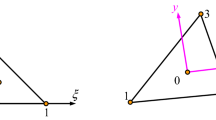Abstract
A new enhanced assumed strain brick element for finite deformations in finite elasticity and plasticity is presented. The element is based on an expansion of shape function derivatives using Taylor series and an extended set of orthogonality conditions that have to be satisfied for an hourglassing free EAS formulation. Such approach has not been applied so far in the context of large deformation three-dimensional problems. It leads to a surprisingly well-behaved locking and hourglassing free element formulation. Major advantage of the new element is its shear locking free performance in the limit of very thin elements, thus it is applicable to shell type problems. Crucial for the derivation of the residual and consistent tangent matrix of the element is the automation of the implementation by automatic code generation.
Similar content being viewed by others
References
Andelfinger U, Ramm E (1993) EAS-elements for two- dimensions, three-dimensional, plate, shell structures and their equivalence to HR-elements. Int J Numer Methods Eng 36: 1311–1337
Armero F (2000) On the locking and stability of finite elements in finite deformation plane strain problems. Comput Struct 75: 261–290
Basar Y, Ding Y (1992) Finite-rotation shell elements for the analysis of finite-rotation shell problems. Int J Numer Methods Eng 34: 165–169
Bischoff M, Ramm E, Braess D (1999) A class of equivalent enhanced assumed strain and hybrid stress finite elements. Comput Mech 22(6): 443–449
Freischläger C, Schweizerhof K (1996) On a systematic development of trilinear 3D solid elements based on Simo’s enhanced strain formulation. Int J Solids Struct 33(20–22): 2993–3017
Glaser S, Armero F (1997) On the formulation of enhanced strain finite elements in finite deformations. Eng Comput 14(6–7): 759
Korelc J (2009) Automation of primal and sensitivity analysis of transient coupled problems. Comput Mech 44: 631–649
Korelc J, Wriggers P (1997) Improved enhanced strain four-node element with Taylor expansion of the shape functions. Int J Numer Methods Eng 40(3): 407–421
Korelc J, Wriggers P (1996) Consistent gradient formulation for a stable enhanced strain method for large deformations. Eng Comput 13(1): 103–123
Korelc J, Wriggers P (1996) An efficient 3D enhanced strain element with Taylor expansion of the shape functions. Comput Mech 19(1): 30–40
Korelc J, AceGen and AceFEM user manual, http://www.fgg.uni-lj.si/symech/
Mathematica, Wolfram Research Inc., http://www.wolfram.com
MacNeal RH, Harder RL (1985) A proposed standard set of problems to test finite element accuracy. Finite Elem Anal Des 1: 3–20
Mueller-Hoeppe D, Loehnert S, Wriggers P (2007) A finite deformation brick element with inhomogeneous mode enhancement. Int J Numer Methods Eng 78(10): 1164–1187
Pantuso D, Bathe KJ (1997) On the stability of mixed finite elements in large strain analysis of incompressible solids. Finite Elem Anal Des 28(2): 83–104
Piltner R, Taylor LR (1995) A quadrilateral mixed finite element with two enhanced strain nodes. Int J Numer Methods Eng 38: 1783–1808
Reese S, Wriggers P (2000) A stabilization technique to avoid hourglassing in finite elasticity. Int J Numer Methods Eng 48(1): 79–109
Reese S (2005) On a physically stabilized one point finite element formulation for three-dimensional finite elasto-plasticity. Comput Methods Appl Mech Eng 194: 4685–4715
Simo JC, Armero F (1992) Geometrically non-linear enhanced strain mixed methods and the method of incompatible modes. Int J Numer Methods Eng 33: 1413–1449
Simo JC, Hughes TJR (1998) Computional inelasticity. Interdisciplinary applied mathematics, vol. 7. Springer, New York
Simo JC, Hughes TJR (1986) On variational foundations of assumed strain methods. J Appl Mech 53(1): 51–54
Simo JC, Rifai KS (1990) A class of mixed assumed strain methods and the method of incompatible modes. Int J Numer Methods Eng 29: 1595–1638
Simo JC, Armero F, Taylor RL (1993) Improved version of assumed enhanced strain tri-linear element for 3D finite deformation problems. Comput Methods Appl Mech Eng 73: 53–92
Wriggers P (2008) Nonlinear finite element methods. Springer, Berlin
Wriggers P, Korelc J (1996) On enhanced strain methods for small and finite deformations. Comput Mech 18(6): 413–428
Wriggers P, Reese S (1996) A note on enhanced strain methods for large deformations. Comput Methods Appl Mech Eng 135 (3–4): 201–209
Author information
Authors and Affiliations
Corresponding author
Rights and permissions
About this article
Cite this article
Korelc, J., Šolinc, U. & Wriggers, P. An improved EAS brick element for finite deformation. Comput Mech 46, 641–659 (2010). https://doi.org/10.1007/s00466-010-0506-0
Received:
Accepted:
Published:
Issue Date:
DOI: https://doi.org/10.1007/s00466-010-0506-0




